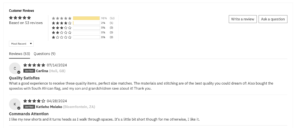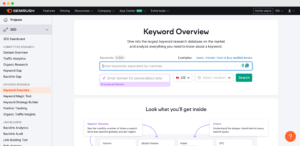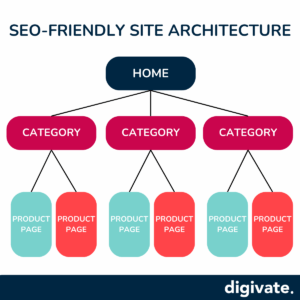
In today’s fiercely competitive online marketplace, standing out and reaching potential customers is a monumental challenge for ecommerce businesses. With countless competitors, simply having an online store is no longer enough.
Failing to optimise your ecommerce website for search engines can lead to a cascade of negative consequences. You could be missing out on a vast pool of potential customers who are actively searching for products or services like yours. This can result in stagnant growth, decreased revenue, and a diminished online presence.
This ecommerce SEO Guide is your roadmap to overcoming these challenges. By the end of this, you will have a clear understanding of how to dominate search engine results, attract organic traffic, and ultimately boost your ecommerce sales. We will delve into essential SEO strategies, provide actionable tips, and equip you with the knowledge to unlock your website’s full potential.
What is Ecommerce SEO?
Ecommerce SEO is the practice of optimising an online store to increase its visibility and organic search rankings. Unlike traditional SEO, it focuses on product pages, categories, and the unique challenges of selling products online.
Ecommerce SEO presents both challenges and opportunities. On one hand, the high competition in most product categories can make it difficult to rank for desired keywords. Additionally, product information can be duplicated across various platforms, leading to potential duplicate content issues. On the other hand, ecommerce sites have the advantage of rich product data, which can be leveraged to enhance search engine visibility.
Product pages are the heart of any ecommerce store. To optimise them for SEO and conversions, focus on:
- Keyword optimisation: Incorporate relevant keywords into product titles, descriptions, and image alt text.
- Compelling product descriptions: Create detailed and informative descriptions that highlight product features and benefits.
- High-quality images: Use clear and visually appealing images with optimised file sizes.
- Customer reviews: Encourage customers to leave reviews and showcase them prominently.
- Clear call-to-actions: Guide customers towards purchasing with strong CTAs.
Category pages serve as a roadmap for customers. Optimising them is crucial for both user experience and SEO.
- Keyword optimisation: Use relevant keywords in category titles, descriptions, and URLs.
- Clear navigation: Create a logical and intuitive category structure.
- Internal linking: Link relevant products and subcategories within each category.
- Product filtering: Implement robust filtering options to help customers refine their searches.
Customer reviews and ratings are indispensable assets for ecommerce businesses. They significantly influence purchase decisions by providing social proof and building trust.

By making it effortless for customers to leave reviews and responding thoughtfully to all feedback, you demonstrate your commitment to customer satisfaction. Optimising reviews to include relevant keywords can boost your search engine visibility, while prominently displaying star ratings entices potential customers to explore your products further.
By focusing on these ecommerce-specific SEO elements, you can significantly enhance your online store’s visibility and drive more sales.
Ecommerce SEO Keyword Research
Keywords are the foundation of SEO – as you can tell, they are important for both category and product pages. Keywords are the search terms people use to find products or information online.
By optimising your website around relevant keywords, you increase your chances of ranking higher in search engine results pages (SERPs). This leads to increased visibility, traffic, and ultimately, sales.
Types of Keywords
There are several types of keywords to consider for your ecommerce store:
- Short-tail keywords: These are broad, general terms with high search volume but high competition. Examples include “women’s shoes” or “smartphones.”
- Long-tail keywords: These are more specific phrases with lower search volume but higher conversion potential. Examples include “red high heels size 8” or “best iPhone 14 Pro camera features.”
- Informational keywords: People use these to learn about a topic, not necessarily to buy. Examples include “what is SEO” or “how to choose running shoes.”
- Transactional keywords: These indicate a strong purchase intent and are therefore your most important keywords for ecommerce. Examples include “buy Nike sneakers” or “iPhone 14 Pro deals.”
While short-tail keywords can be challenging to rank for, a combination of short-tail and long-tail keywords can be effective for ecommerce businesses.
Effective Keyword Research
To conduct effective keyword research, consider the following tips:
- Utilise keyword research tools: Tools like Google Keyword Planner, Semrush (this is what we use), and Ahrefs offer valuable insights into keyword search volume, competition, and related search terms.

- Analyse competitor keywords: See what keywords your competitors are ranking for to identify opportunities.
- Consider user intent: Understand what people are looking for when searching for a specific keyword.
- Focus on relevance: Prioritise keywords that align with your products and services.
- Create keyword clusters: Group related keywords together to optimise your content and website structure.
On-Page SEO For Ecommerce Websites
On-page SEO refers to the optimisation of elements within a webpage to improve its search engine ranking and user experience.

Title tags, meta descriptions, and header tags are fundamental to on-page SEO. Title tags are the clickable headlines in search results, and meta descriptions are the brief summaries below. Both should accurately reflect the page content and include relevant keywords. Header tags (H1, H2, H3, etc.) structure content hierarchically, helping search engines understand page content.
High-quality product descriptions and images are essential for ecommerce success. Detailed, informative product descriptions that incorporate relevant keywords can enhance user experience and search engine rankings. Similarly, compelling product images with optimised alt text improve user engagement and accessibility.
Optimising URL structure and internal linking is crucial for navigation and SEO. Clear, concise URLs containing relevant keywords improve both user experience and search engine readability. Internal linking helps distribute page authority and guides users through your website.
Schema markup is a structured data format that helps search engines understand your content. By implementing schema markup, you can improve your website’s appearance in search results, potentially including rich snippets with additional information like product ratings or prices. This can significantly increase click-through rates.
Technical SEO Aspects
Technical SEO is the backbone of a successful ecommerce website. It focuses on the technical aspects of a website that impact its visibility and ranking in search engines. While often overlooked, it plays a crucial role in ensuring that search engines can easily crawl, index, and understand your site.
Website Speed Optimisation and Mobile-Friendliness
- Importance: Google prioritises fast-loading websites, and mobile usage has surpassed desktop. A slow or unresponsive site can lead to high bounce rates and poor user experience.
- Optimisation:
- Optimise image sizes so they are high-quality but small in size.
- Minimise HTTP requests.
- Leverage browser caching.
- Utilise a Content Delivery Network (CDN).
- Ensure mobile responsiveness.
Site Structure and Navigation
- Importance: A well-organised site structure helps both users and search engines understand your website’s content.
- Best practices:
- Create a clear hierarchy of categories and subcategories.
- Use internal linking to connect related pages.
- Implement a logical navigation menu.
- Ensure clear and concise URL structures.

XML Sitemaps and Robots.txt
An XML Sitemap is essential for ecommerce stores as it helps search engines discover a vast number of product pages, categories, and other important content. By submitting your XML sitemap to search engines, you increase the likelihood that your entire product catalogue will be indexed.
A Robots.txt file is equally important for ecommerce websites. You can use it to prevent search engines from crawling and indexing sensitive areas of your site, such as internal search results pages or checkout pages. This helps focus search engine resources on the most valuable content, such as product pages and category pages. Additionally, you can use Robots.txt to manage the crawl rate, preventing your server from being overwhelmed by excessive crawling activity.
Duplicate Content and Broken Links
Ecommerce websites are particularly susceptible to duplicate content issues due to product variations, filtering options, and category pages. To avoid penalties, implement canonical tags to specify the preferred version of a product page. For example, if you have multiple product pages with different colours or sizes, use canonical tags to point to the main product page.
Broken links are also a common problem in ecommerce, especially when dealing with product availability or seasonal changes. Regularly audit your website for broken links and implement 301 redirects to send visitors to the correct page or a relevant alternative.
Conclusion
Mastering ecommerce SEO is a multifaceted endeavour that requires a holistic approach. By combining keyword research, on-page optimisation, technical SEO, and a deep understanding of your target audience, you can significantly enhance your online store’s visibility and drive organic growth. Remember, SEO is an ongoing process that demands continuous monitoring and adaptation.
While achieving top search engine rankings requires time and effort, the rewards are substantial. Increased organic traffic, higher conversion rates, and improved brand visibility are just some of the benefits of a well-optimised ecommerce store. By implementing the strategies outlined in this guide, you’ll be well-equipped to compete in the dynamic world of online retail and achieve long-term success.
Remember: SEO is a long-term investment. Stay patient, persistent, and data-driven in your approach.



